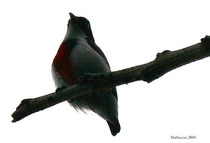Visayan flowerpecker
Its natural habitats are subtropical or tropical moist lowland forests, subtropical or tropical moist montane forests, subtropical or tropical moist shrubland, and rural gardens. It is threatened by habitat loss.
The Visayan flowerpecker is classified as Vulnerable (VU), considered to be facing a high risk of extinction in the wild.
We had seen the endemic Visayan Flowerpecker in the little village, and White-vented Whistler in the secondary forest, but the real prizes were in the primary forest: a noisy flock of White-winged Cuckoo-Shrike (photo below left) and then a small party of curious Flame-templed Babbler (photo below right). Both species are entirely restricted to Negros and Panay, and neither has many published photographs. We also had local Visayan races of White-browed Shama and Blue-headed Fantail, each candidates for a future split. More
We will also look for Visayan Flowerpecker at Mambucal. Return to L’ Fisher hotel. Day 17: We take an early morning flight from Bacolod to Cebu. Upon arrival, we drive to the Cebu port and take a Supercat ferry to Tagbilaran City, Bohol. This small island north of Mindanao is famous for wonderful dive spots, dolphin and whale-watching, and its white-sandy beaches and crystal clear waters. First stop is the Chocolate Hills Hotel, where we will stay for two nights. More

Original source: Blake Matheson
-Blake Matheson -Author: Blake Matheson
Permission: Some rights reserved
Family : Dicaeidae
Genus : Dicaeum
Species : haematostictum
Authority : Sharpe, 1876

